16 Oracle CQL Statements
This chapter describes data definition language (DDL) statements in Oracle Continuous Query Language (Oracle CQL).
This chapter includes the following section:
16.1 Introduction to Oracle CQL Statements
Oracle CQL supports the following DDL statements:
Note:
In stream input examples, lines beginning with h (such as h 3800) are heartbeat input tuples. These inform Oracle Event Processing that no further input will have a timestamp lesser than the heartbeat value.
For more information, see:
16.2 Query
Purpose
Use the query statement to define a Oracle CQL query that you reference by identifier in subsequent Oracle CQL statements.
Prerequisites
If your query references a stream or view, then the stream or view must already exist.
If the query already exists, Oracle Event Processing server throws an exception.
For more information, see:
Syntax
You express a query in a <query></query> element.
The query element has one attribute:
-
id: Specify theidentifieras thequeryelementidattribute.
<query id="q0"><![CDATA[
select * from OrderStream where orderAmount > 10000.0
]]></query>
Figure 16-1 query::=

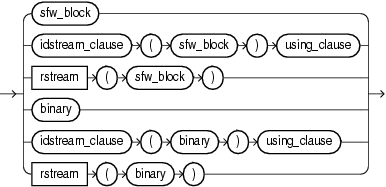
Figure 16-2 sfw_block::=
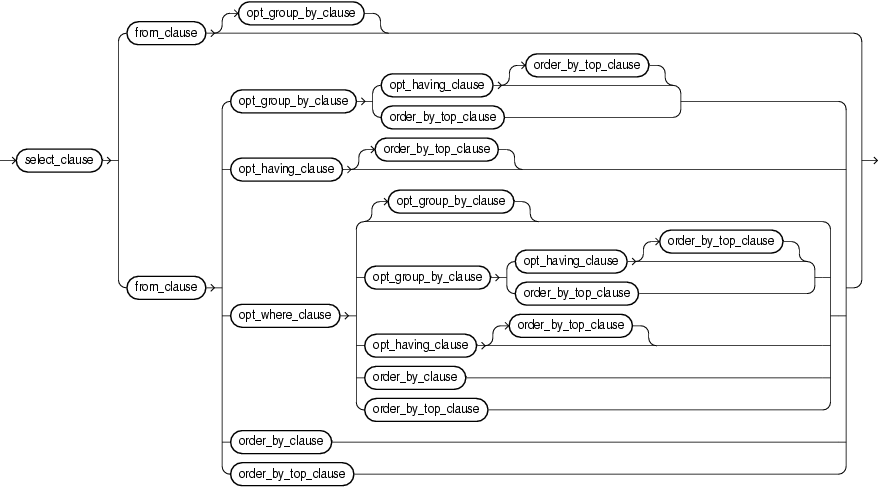
Figure 16-3 select_clause::=

Figure 16-4 non_mt_projterm_list::=
Figure 16-5 projterm::=
(arith_expr )
Figure 16-6 from_clause::=

Figure 16-7 non_mt_relation_list::=
Figure 16-8 relation_variable::=
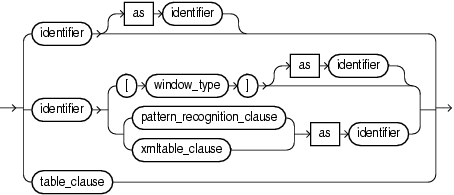
Figure 16-9 window_type::=
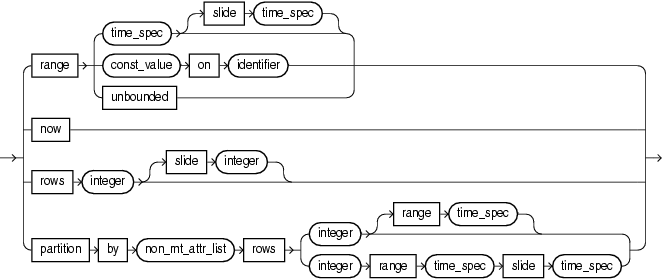
Figure 16-10 table_clause::=
Figure 16-11 opt_where_clause::=
Figure 16-12 opt_group_by_clause::=
Figure 16-13 order_by_clause::=
Figure 16-14 order_by_top_clause::=

Figure 16-15 order_by_list::=
Figure 16-16 orderterm::=

Figure 16-17 null_spec::=

Figure 16-18 asc_desc::=

Figure 16-19 opt_having_clause::=
Figure 16-20 binary::=
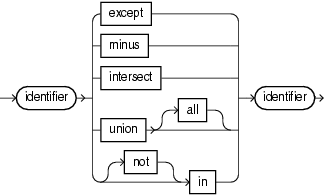
Figure 16-21 idstream_clause::=

Figure 16-22 using_clause::=
Figure 16-23 usinglist::=
Figure 16-24 usingterm::=
Figure 16-25 usingexpr::=

Figure 16-26 xmltable_clause::=
Figure 16-27 xmlnamespace_clause::=
Figure 16-28 xmlnamespaces_list::=
Figure 16-29 xml_namespace::=

Figure 16-30 xtbl_cols_list::=
Figure 16-31 xtbl_col::=

16.2.1 Query Semantics
query
You can create an Oracle CQL query from any of the following clauses:
-
sfw_block: a select, from, and other optional clauses. -
binary: an optional clause, often a set operation. -
xstream_clause: apply an optional relation-to-stream operator to yoursfw_blockorbinaryclause to control how the query returns its results.
sfw_block
Specify the select, from, and other optional clauses of the Oracle CQL query. You can specify any of the following clauses:
-
select_clause: the stream elements to select from the stream or view you specify. -
from_clause: the stream or view from which your query selects. -
opt_where_clause: optional conditions your query applies to its selection -
opt_group_by_clause: optional grouping conditions your query applies to its resultorder_by_clause: optional ordering conditions your query applies to its results -
order_by_top_clause: optional ordering conditions your query applies to the top-nelements in its results -
opt_having_clause: optional clause your query uses to restrict the groups of returned stream elements to those groups for which the specifiedconditionisTRUE
select_clause
Specify the select clause of the Oracle CQL query statement.
If you specify the asterisk (*), then this clause returns all tuples, including duplicates and nulls.
Otherwise, specify the individual stream elements you want.
Optionally, specify distinct if you want Event Processing to return only one copy of each set of duplicate tuples selected. Duplicate tuples are those with matching values for each expression in the select list.
non_mt_projterm_list
Specify the projection term or comma separated list of projection terms in the select clause of the Oracle CQL query statement.
projterm
Specify a projection term in the select clause of the Oracle CQL query statement. You can select any element from any of stream or view in the from_clause using the identifier of the element.
Optionally, you can specify an arithmetic expression on the projection term.
Optionally, use the AS keyword to specify an alias for the projection term instead of using the stream element name as is.
from_clause
Specify the from clause of the Oracle CQL query statement by specifying the individual streams or views from which your query selects.
To perform an outer join, use the LEFT or RIGHT OUTER JOIN ... ON syntax. To perform an inner join, use the WHERE clause.
non_mt_relation_list
Specify the stream or view or comma separated list of streams or views in the from clause of the Oracle CQL query statement.
relation_variable
Use the relation_variable statement to specify a stream or view from which the Oracle CQL query statement selects.
You can specify a previously registered or created stream or view directly by its identifier you used when you registered or created the stream or view. Optionally, use the AS keyword to specify an alias for the stream or view instead of using its name as is.
To specify a built-in stream-to-relation operator, use a window_type clause. Optionally, use the AS keyword to specify an alias for the stream or view instead of using its name as is.
To apply advanced comparisons optimized for data streams to the stream or view, use a pattern_recognition_clause . Optionally, use the AS keyword to specify an alias for the stream or view instead of using its name as is.
To process xmltype stream elements using XPath and XQuery, use an xmltable_clause. Optionally, use the AS keyword to specify an alias for the stream or view instead of using its name as is.
To access, as a relation, the multiple rows returned by a data cartridge function in the FROM clause of an Oracle CQL query, use a table_clause.
For more information, see:
-
View.
window_type
Specify a built-in stream-to-relation operator.
For more information, see Stream-to-Relation Operators (Windows).
table_clause
Use the data cartridge TABLE clause to access the multiple rows returned by a data cartridge function in the FROM clause of an Oracle CQL query.
The TABLE clause converts the set of returned rows into an Oracle CQL relation. Because this is an external relation, you must join the TABLE function clause with a stream. Oracle Event Processing invokes the data cartridge method only on the arrival of elements on the joined stream.
Use the optional OF keyword to specify the type contained by the returned array type or Collection type.
Use the AS keyword to specify an alias for the object_expr and for the returned relation.
Note the following:
-
The data cartridge method must return an array type or
Collectiontype. -
You must join the
TABLEfunction clause with a stream.
time_spec
Specify the time over which a range or partitioned range sliding window should slide.
Default: if units are not specified, Oracle Event Processing assumes [second|seconds].
For more information, see Range-Based Stream-to-Relation Window Operators and Partitioned Stream-to-Relation Window Operators.
opt_where_clause
Specify the (optional) where clause of the Oracle CQL query statement.
Because Oracle CQL applies the WHERE clause before GROUP BY or HAVING, if you specify an aggregate function in the SELECT clause, you must test the aggregate function result in a HAVING clause, not the WHERE clause.
In Oracle CQL (as in SQL), the FROM clause is evaluated before the WHERE clause. Consider the following Oracle CQL query:
SELECT ... FROM S MATCH_RECOGNIZE ( .... ) as T WHERE ...
In this query, the S MATCH_RECOGNIZE ( .... ) as T is like a subquery in the FROM clause and is evaluated first, before the WHERE clause. Consequently, you rarely use both a MATCH_RECOGNIZE clause and a WHERE clause in the same Oracle CQL query. Instead, you typically use views to apply the required WHERE clause to a stream and then select from the views in a query that applies the MATCH_RECOGNIZE clause.
For more information, see:
opt_group_by_clause
Specify the (optional) GROUP BY clause of the Oracle CQL query statement. Use the GROUP BY clause if you want Oracle Event Processing to group the selected stream elements based on the value of expr(s) and return a single (aggregate) summary result for each group.
Expressions in the GROUP BY clause can contain any stream elements or views in the FROM clause, regardless of whether the stream elements appear in the select list.
The GROUP BY clause groups stream elements but does not guarantee the order of the result set. To order the groupings, use the ORDER BY clause.
Because Oracle CQL applies the WHERE clause before GROUP BY or HAVING, if you specify an aggregate function in the SELECT clause, you must test the aggregate function result in a HAVING clause, not the WHERE clause.
For more information, see:
order_by_clause
Specify the ORDER BY clause of the Oracle CQL query statement as a comma-delimited list of one or more order terms. Use the ORDER BY clause to specify the order in which stream elements on the left-hand side of the rule are to be evaluated. The expr must resolve to a dimension or measure column. This clause returns a stream.
Both ORDER BY and ORDER BY ROWS support specifying the direction of sort as ascending or descending by using the ASC or DESC keywords. They also support specifying whether null items should be listed first or last when sorting by using NULLS FIRST or NULLS LAST.
For more information, see:
order_by_top_clause
Specify the ORDER BY clause of the Oracle CQL query statement as a comma-delimited list of one or more order terms followed by a ROWS keyword and integer number (n) of elements. Use this form of the ORDER BY clause to select the top-n elements over a stream or relation. This clause returns a relation.
Consider the following example queries:
-
At any point of time, the output of the following example query will be a relation having top 10 stock symbols throughout the stream.
select stock_symbols from StockQuotes order by stock_price rows 10
-
At any point of time, the output of the following example query will be a relation having top 10 stock symbols from last 1 hour of data.
select stock_symbols from StockQuotes[range 1 hour] order by stock_price rows 10
For more information, see:
order_by_list
Specify a comma-delimited list of one ore more order terms in an (optional) ORDER BY clause.
orderterm
A stream element or positional index (constant int) to a stream element. Optionally, you can configure whether or not nulls are ordered first or last using the NULLS keyword.
order_expr
order_expr can be an attr or constant_int. The attr can be any stream element or pseudo column.
null_spec
Specify whether or not nulls are ordered first (NULLS FIRST) or last (NULLS LAST) for a given order term.
asc_desc
Specify whether an order term is ordered in ascending (ASC) or descending (DESC) order.
opt_having_clause
Use the HAVING clause to restrict the groups of returned stream elements to those groups for which the specified condition is TRUE. If you omit this clause, then Oracle Event Processing returns summary results for all groups.
Specify GROUP BY and HAVING after the opt_where_clause. If you specify both GROUP BY and HAVING, then they can appear in either order.
Because Oracle CQL applies the WHERE clause before GROUP BY or HAVING, if you specify an aggregate function in the SELECT clause, you must test the aggregate function result in a HAVING clause, not the WHERE clause.
For more information, see:
binary
Use the binary clause to perform operations on the tuples that two streams or views return. Most of these perform set operations, receiving two relations as operands. However, the UNION ALL operator can instead receive two streams, which are by nature unbounded.
idstream_clause
Use an idstream_clause to specify an IStream or DStream relation-to-stream operator that applies to the query.
For more information, see Relation-to-Stream Operators.
using_clause
Use a DIFFERENCE USING clause to succinctly detect differences in the IStream or DStream of a query.
For more information, see Detecting Differences in Query Results.
usinglist
Use a usinglist clause to specify the columns to use to detect differences in the IStream or DStream of a query. You may specify columns by:
-
attribute name: use this option when you are selecting by attribute name.
-
alias: use this option when you want to include the results of an expression where an alias is specified.
-
position: use this option when you want to include the results of an expression where no alias is specified.
Specify position as a constant, positive integer starting at 1, reading from left to right.
The following example specifies the result of expression
funct(c2, c3)by its position (3) in theDIFFERENCE USINGclauseusinglist.
<query id="q1">
ISTREAM (
SELECT c1, log(c4) as logval, funct(c2, c3) FROM S [RANGE 1 NANOSECONDS]
) DIFFERENCE USING (c1, logval, 3)
</query>
For more information, see Detecting Differences in Query Results.
xmltable_clause
Use an xmltable_clause to process xmltype stream elements using XPath and XQuery. You can specify a comma separated list of one or more XML table columns, with or without an XML namespace.
pattern_recognition_clause
Use a pattern_recognition_clause to perform advanced comparisons optimized for data streams.
For more information and examples, see Pattern Recognition With MATCH_RECOGNIZE.
16.2.2 Query Examples
For more examples, see Oracle CQL Queries, Views, and Joins.
Simple Query Example
The following example shows how to register a simple query q0 that selects all (*) tuples from stream OrderStream where stream element orderAmount is greater than 10000.
<query id="q0"><![CDATA[
select * from OrderStream where orderAmount > 10000.0
]]></query>
HAVING Example
Consider the query q4 and the data stream S2. Stream S2 has schema (c1 integer, c2 integer). The query returns the relation.
<query id="q4"><![CDATA[
select
c1,
sum(c1)
from
S2[range 10]
group by
c1
having
c1 > 0 and sum(c1) > 1
]]></query>
Timestamp Tuple 1000 ,2 2000 ,4 3000 1,4 5000 1, 6000 1,6 7000 ,9 8000 ,
Timestamp Tuple Kind Tuple 5000: + 1,2 6000: - 1,2 6000: + 1,3
BINARY Example: UNION and UNION ALL
The UNION and UNION ALL operators both take two operands and combine their elements. The result of the UNION ALL operator includes all of the elements from the two operands, including duplicates. The result of the UNION operator omits duplicates.
The UNION operator accepts only two relations and produces a relation as its output. This operator cannot accept streams because in order to remove duplicates, the Oracle CQL engine must keep track of all of the elements contained in both operands. This is not possible with streams, which are by nature unbounded.
The UNION ALL operator accepts either two streams (and producing a stream) or two relations (producing a relation) as its operands. Using one stream and one relation as operands is invalid for both operators.
Given the relations R1 and R2, respectively, the UNION query q1 returns the relation and the UNION ALL query q2 returns the relation.
<query id="q1"><![CDATA[
R1 UNION R2
]]></query>
<query id="q2"><![CDATA[
R1 UNION ALL R2
]]></query>
Timestamp Tuple Kind Tuple 200000: + 20,0.2 201000: - 20,0.2 400000: + 30,0.3 401000: - 30,0.3 100000000: + 40,4.04 100001000: - 40,4.04
Timestamp Tuple Kind Tuple
1002: + 15,0.14
2002: - 15,0.14
200000: + 20,0.2
201000: - 20,0.2
400000: + 30,0.3
401000: - 30,0.3
100000000: + 40,4.04
100001000: - 40,4.04
Timestamp Tuple Kind Tuple
1002: + 15,0.14
2002: - 15,0.14
200000: + 20,0.2
201000: - 20,0.2
400000: + 30,0.3
401000: - 30,0.3
100000000: + 40,4.04
100001000: - 40,4.04
Note:
UNION is one of the binary operator which removes duplicates in its output. The above is a trivial case where the attributes are of CQL native types. In case of an input relation with an OBJECT type attribute, user must add a correct implementation of hashCode() and equals() method in their Object definition class so that CQL Engine can compute the equality of member object attributes in two comparing tuples.
The following output is from using UNION ALL with two relations as operands.
Timestamp Tuple Kind Tuple
1002: + 15,0.14
2002: - 15,0.14
200000: + 20,0.2
200000: + 20,0.2
20100: - 20,0.2
201000: - 20,0.2
400000: + 30,0.3
400000: + 30,0.3
401000: - 30,0.3
401000: - 30,0.3
100000000: + 40,4.04
100000000: + 40,4.04
10001000: - 40,4.04
100001000: - 40,4.04
Timestamp Tuple 100000: 20,0.1 150000: 15,0.1 200000: 5,0.2 400000: 30,0.3 100000000: 8,4.04
Timestamp Tuple
1001: 10,0.1
1002: 15,0.14
200000: 20,0.2
400000: 30,0.3
100000000: 40,4.04
The following output is from using UNION ALL with the two preceding streams as operands. Note that all of the elements are inserted events.
Timestamp Tuple Kind Tuple
1001: + 10,0.1
1002: + 15,0.14
100000: + 20,0.1
150000: + 15,0.14
200000: + 20,0.2
200000: + 5,0.2
400000: + 30,0.3
400000: + 30,0.3
100000000: + 40,4.04
100000000: + 8,4.04
BINARY Example: INTERSECT
The INTERSECT operator returns a relation (with duplicates removed) with only those elements that appear in both of its operand relations.
Given the relations R1 and R2, respectively, the INTERSECT query q1 returns the relation.
<query id="q1"><![CDATA[
R1 INTERSECT R2
]]></query>
Timestamp Tuple Kind Tuple 1000: + 10,30 1000: + 10,40 2000: + 11,20 3000: - 10,30 3000: - 10,40
Timestamp Tuple Kind Tuple 1000: + 10,40 2000: + 10,30 2000: - 10,40 3000: - 10,30
Timestamp Tuple Kind Tuple 1000: + 10,40 2000: + 10,30 2000: - 10,40 3000: - 10,30
BINARY Example: EXCEPT and MINUS
As in database programming, the EXCEPT and MINUS operators are very similar. They both take relations as their two operands. Both result in a relation that is essentially elements of the first operand relation that are not also in the second operand relation.
An important difference between EXCEPT and MINUS is in how they handle duplicate occurrences between the first and second relation operands, as follows:
-
The EXCEPT operator results in a relation made up of elements from the first relation, removing elements that were also found in the second relation up to the number of duplicate elements found in the second relation. In other words, if an element occurs m times in the first relation and n times in the second, the number of that element in the result will be n subtracted from m, or 0 if there were fewer in m than n.
-
The MINUS operator results in a relation made up of elements in the first relation minus those elements that were also found in the second relation, regardless of how many of those elements were found in each. The MINUS operator also removes duplicate elements found in the first relation, so that each duplicate item is unique in the result.
The following examples illustrate the MINUS operator. Given the relations R1 and R2, respectively, the MINUS query q1 returns the relation.
<query id="q1BBAQuery"><![CDATA[
R1 MINUS R2
]]></query>
Timestamp Tuple Kind Tuple 1500: + 10,40 1800: + 10,30 2000: + 10,40 2000: + 10,40 2100: - 10,40 3000: - 10,30
Timestamp Tuple Kind Tuple 1000: + 11,20 2000: + 10,40 3000: - 10,30
Timestamp Tuple Kind Tuple 1500: + 10,40 1800: + 10,30 2000: - 10,40
The following examples illustrate the EXCEPT operator. Given the relations R1 and R2, respectively, the EXCEPT query q1 returns the relation.
<query id="exceptQuery"><![CDATA[
R1 EXCEPT R2
]]></query>
Timestamp Tuple Kind Tuple 1500: + 10,40 1800: + 10,30 2000: + 10,40 2000: + 10,40 2100: - 10,40 3000: - 10,30
Timestamp Tuple Kind Tuple 1000: + 11,20 2000: + 10,40 3000: - 10,40
Timestamp Tuple Kind Tuple 1500: + 10,40 1800: + 10,30 2000: + 10,40 2000: - 10,40
BINARY Example: IN and NOT IN
In this usage, the query will be a binary query.
in_condition_set::=
Note:
You cannot combine this usage with in_condition_membership as Using IN and NOT IN as a Membership Condition describes.
Consider the views V3 and V4 and the query Q1 and the data streams S3 (with schema (c1 integer, c2 integer)) and S4 (with schema (c1 integer, c2 integer)). In this condition test, the numbers and data types of attributes in left relation should be same as number and types of attributes of the right relation. The following example shows the relation that the query returns.
<view id="V3" schema="c1 c2"><![CDATA[
select * from S3[range 2]
]]></query>
<view id="V4" schema="c1 d1"><![CDATA[
select * from S4[range 1]
]]></query>
<query id="Q1"><![CDATA[
v3 not in v4
]]></query>
Timestamp Tuple 1000 10, 30 1000 10, 40 2000 11, 20 3000 12, 40 3000 12, 30 3000 15, 50 h 2000000
Timestamp Tuple 1000 10, 40 2000 10, 30 2000 12, 40 h 2000000
Timestamp Tuple Kind Tuple 1000: + 10,30 1000: + 10,40 1000: - 10,30 1000: - 10,40 2000: + 11,20 2000: + 10,30 2000: + 10,40 2000: - 10,30 2000: - 10,40 3000: + 15,50 3000: + 12,40 3000: + 12,30 4000: - 11,20 5000: - 12,40 5000: - 12,30 5000: - 15,50
Select and Distinct Examples
Consider the query q1. Given the data stream S, the query returns the relation.
<query id="q1"><![CDATA[
SELECT DISTINCT c1 FROM S WHERE c1 > 10
]]></query>
Timestamp Tuple 1000 23 2000 14 3000 13 5000 22 6000 11 7000 10 8000 9 10000 8 11000 7 12000 13 13000 14
Timestamp Tuple 1000 23 2000 14 3000 13 5000 22 6000 11
XMLTABLE Query Example
Consider the query q1 and the data stream S. Stream S has schema (c1 xmltype). The query returns the relation.
For a more complete description of XMLTABLE, see XMLTABLE Query.
<query id="q1"><![CDATA[
SELECT
X.Name,
X.Quantity
FROM S1,
XMLTABLE (
"//item" PASSING BY VALUE S1.c2 as "."
COLUMNS
Name CHAR(16) PATH "/item/productName",
Quantity INTEGER PATH "/item/quantity"
) AS X
]]></query>
Timestamp Tuple 3000 "<purchaseOrder><shipTo><name>Alice Smith</name><street>123 Maple Street</street><city>Mill Valley</city><state>CA</state><zip>90952</zip> </shipTo><billTo><name>Robert Smith</name><street>8 Oak Avenue</street><city>Old Town</city><state>PA</state> <zip>95819</zip> </billTo><comment>Hurry, my lawn is going wild!</comment><items> <item><productName>Lawnmower </productName><quantity>1</quantity><USPrice>148.95</USPrice><comment>Confirm this is electric</comment></item><item> <productName>Baby Monitor</productName><quantity>1</quantity> <USPrice>39.98</USPrice> <shipDate>1999-05-21</shipDate></item></items> </purchaseOrder>" 4000 "<a>hello</a>"
Timestamp Tuple Kind Tuple 3000: + <productName>Lawnmower</productName>,<quantity>1</quantity> 3000: + <productName>Baby Monitor</productName>,<quantity>1</quantity>
XMLTABLE With XML Namespaces Query Example
Consider the query q1 and the data stream S1. Stream S1 has schema (c1 xmltype). The query returns the relation.
For a more complete description of XMLTABLE, see XMLTABLE Query.
<query id="q1"><![CDATA[
SELECT *
FROM S1,
XMLTABLE (
XMLNAMESPACES('http://example.com' as 'e'),
'for $i in //e:emps return $i/e:emp' PASSING BY VALUE S1.c1 as "."
COLUMNS
empName char(16) PATH 'fn:data(@ename)',
empId integer PATH 'fn:data(@empno)'
) AS X
]]></query>
Timestamp Tuple 3000 "<emps xmlns=\"http://example.com\"><emp empno=\"1\" deptno=\"10\" ename=\"John\" salary=\"21000\"/><emp empno=\"2\" deptno=\"10\" ename=\"Jack\" salary=\"310000\"/><emp empno=\"3\" deptno=\"20\" ename=\"Jill\" salary=\"100001\"/></emps>" h 4000
Timestamp Tuple Kind Tuple 3000: + John,1 3000: + Jack,2 3000: + Jill,3
Data Cartridge TABLE Query Example: Iterator
Consider a data cartridge (MyCartridge) with method getIterator.
...
public static Iterator<Integer> getIterator() {
ArrayList<Integer> list = new ArrayList<Integer>();
list.add(1);
list.add(2);
return list.iterator();
}
...
Consider the query q1. Given the data stream S0, the query returns the relation.
<query id="q1"><![CDATA[
select S1.c1, S1.c2, S2.c1
from
S0[now] as S1,
table (com.acme.MyCartridge.getIterator() as c1) of integer as S2
]]></query>
Timestamp Tuple 1 1, abc 2 2, ab 3 3, abc 4 4, a h 200000000
Timestamp Tuple Kind Tuple 1: + 1,abc,1 1: + 1,abc,2 1: - 1,abc,1 1: - 1,abc,2 2: + 2,ab,1 2: + 2,ab,2 2: - 2,ab,1 2: - 2,ab,2 3: + 3,abc,1 3: + 3,abc,2 3: - 3,abc,1 3: - 3,abc,2 4: + 4,a,1 4: + 4,a,2 4: - 4,a,1 4: - 4,a,2
Data Cartridge TABLE Query Example: Array
Consider a data cartridge (MyCartridge) with method getArray.
...
public static Integer[] getArray(int c1) {
ArrayList<Integer> list = new ArrayList<Integer>();
list.add(1);
list.add(2);
return list.toArray(new Integer[2]);;
}
...
Consider the query q1. Given the data stream S0, the query returns the relation.
<query id="q1"><![CDATA[
select S1.c1, S1.c2, S2.c1
from
S0[now] as S1,
table (com.acme.MyCartridge.getArrayS1.c1) as c1) of integer as S2
]]></query>
Timestamp Tuple 1 1, abc 2 2, ab 3 3, abc 4 4, a h 200000000
Timestamp Tuple Kind Tuple 1: + 1,abc,1 1: + 1,abc,2 1: - 1,abc,1 1: - 1,abc,2 2: + 2,ab,2 2: + 2,ab,4 2: - 2,ab,2 2: - 2,ab,4 3: + 3,abc,3 3: + 3,abc,6 3: - 3,abc,3 3: - 3,abc,6 4: + 4,a,4 4: + 4,a,8 4: - 4,a,4 4: - 4,a,8
Data Cartridge TABLE Query Example: Collection
Consider a data cartridge (MyCartridge) with method getCollection.
...
public HashMap<Integer,String> developers;
developers = new HashMap<Integer,String>();
developers.put(2, "Mohit");
developers.put(4, "Unmesh");
developers.put(3, "Sandeep");
developers.put(1, "Swagat");
public HashMap<Integer,String> qaengineers;
qaengineers = new HashMap<Integer,String>();
qaengineers.put(4, "Terry");
qaengineers.put(5, "Tony");
qaengineers.put(3, "Junger");
qaengineers.put(1, "Arthur");
...
public Collection<String> getEmployees(int exp_yrs) {
LinkedList<String> employees = new LinkedList<String>();
employees.add(developers.get(exp_yrs));
employees.add(qaengineers.get(exp_yrs));
return employees;
}
...
Consider the query q1. Given the data stream S0, the query returns the relation.
<query id="q1"><![CDATA[
RStream(
select S1.c1, S2.c1
from
S0[now] as S1,
table(S1.c2.getEmployees(S1.c1) as c1) of char as S2
)
]]></query>
Timestamp Tuple 1 1, abc 2 2, ab 3 3, abc 4 4, a h 200000000
Timestamp Tuple Kind Tuple 1: + 1,Swagat 1: + 1,Arthur 2: + 2,Mohit 3: + 3,Sandeep 3: + 3,Junger 4: + 4,Unmesh 4: + 4,Terry
ORDER BY Query Example
Use the ORDER BY clause with stream input to sort events that have duplicate timestamps. ORDER BY is only valid when the input is a stream and only sorts among events of the same timestamp. Its output is a stream with the sorted events.
Consider the query q1. Given the data stream S0, the query returns the relation. The query sorts events of duplicate timestamps in ascending order by tuple values.
<query id="q1"><![CDATA[
SELECT *
FROM S0
ORDER BY c1,c2 ASC
]]></query>
Timestamp Tuple 1000 7, 15 2000 7, 14 2000 5, 23 2000 5, 15 2000 5, 15 2000 5, 25 3000 3, 12 3000 2, 13 4000 4, 17 5000 1, 9 h 1000000000
Timestamp Tuple Kind Tuple 1000: + 7,15 2000: + 5,15 2000: + 5,15 2000: + 5,23 2000: + 5,25 3000: + 2,13 3000: + 3,19 4000: + 4,17 5000: + 1,9
ORDER BY ROWS Query Example
Use the ORDER BY clause with the ROWS keyword to use ordering criteria to determine whether an event received by the query should be included in output. ORDER BY ROWS accepts either stream or relation input and outputs a relation.
The ORDER BY ROWS clause maintains a set of events whose maximum size is the number specified by the ROWS keyword. As new events are received, they are evaluated, based on thr order criteria and the ROWS limit, to determine whether they will be added to the output.
Note that the output of ORDER BY ROWS is not arranged based on the ordering criteria, as is the output of the ORDER BY clause. Instead, ORDER BY ROWS uses the ordering criteria and specified number of rows to determine whether to admit events into the output as they are received.
Consider the query q1. Given the data stream S0, the query returns the relation.
<query id="q1"><![CDATA[
SELECT c1 ,c2
FROM S0
ORDER BY c1,c2 ROWS 5
]]></query>
Timestamp Tuple 1000 7, 15 2000 7, 14 2000 5, 23 2000 5, 15 2000 5, 15 2000 5, 25 3000 2, 13 3000 3, 19 4000 4, 17 5000 1, 9 h 1000000000
Timestamp Tuple Kind Tuple 1000: + 7,15 2000: + 7,14 2000: + 5,23 2000: + 5,15 2000: + 5,15 2000: - 7,15 2000: + 5,25 3000: - 7,14 3000: + 2,13 3000: - 5,25 3000: + 3,19 4000: - 5,23 4000: + 4,17 5000: - 5,15 5000: + 1,9
In the following example, the query uses the PARTITION keyword to specify the tuple property within which to sort events and constrain output size. Here, the PARTITION keyword specifies that events in the input should be evaluated based on their symbol value.
In other words, when determining whether to include an event in the output, the query looks at the existing set of events in output that have the same symbol. The ROWS limit is two, meaning that the query will maintain a set of sorted events that has no more than two events in it. For example, if there are already two events with the ORCL symbol, adding another ORCL event to the output will require deleting the oldest element in output having the ORCL symbol.
Also, the query is ordering events by the value property, so that is also considered when a new event is being considered for output. Here, the DESC keyword specifies that event be ordered in descending order. A new event that does not come after events already in the output set will not be included in output.
<query id="q1"><![CDATA[
SELECT symbol, value
FROM S0
ORDER BY value DESC ROWS 2
PARTITION BY symbol
]]></query>
Timestamp Tuple 1000 ORCL, 500 1100 MSFT, 400 1200 INFY, 200 1300 ORCL, 503 1400 ORCL, 509 1500 ORCL, 502 1600 MSFT, 405 1700 INFY, 212 1800 INFY, 209 1900 ORCL, 512 2000 ORCL, 499 2100 MSFT, 404 2200 MSFT, 403 2300 INFY, 215 2400 MSFT, 415 2500 ORCL, 499 2600 INFY, 211
Timestamp Tuple Kind Tuple 1000 + ORCL,500 1100 + MSFT,400 1200 + INFY,200 1300 + ORCL,503 1400 - ORCL,500 1400 + ORCL,509 1600 + MSFT,405 1700 + INFY,212 1800 - INFY,200 1800 + INFY,209 1900 - ORCL,503 1900 + ORCL,512 2100 - MSFT,400 2100 + MSFT,404 2300 - INFY,209 2300 + INFY,215 2400 - MSFT,404 2400 + MSFT,415
16.3 View
Purpose
Use view statement to create a view over a base stream or relation that you reference by identifier in subsequent Oracle CQL statements.
Syntax
You express the a view in a <view></view> element as the example below shows.
The view element has two attributes:
-
id: Specify theidentifieras theviewelementidattribute.The
idvalue must conform with the specification given by Figure 7-6. -
schema: Optionally, specify the schema of the view as a space delimited list of attribute names.Oracle Event Processing server infers the types.
<view id="v2" schema="cusip bid ask"><![CDATA[
IStream(select * from S1[range 10 slide 10])
]]></view>
The body of the view has the same syntax as a query. For more information, see Query.
Examples
The following examples illustrate the various semantics that this statement supports. For more examples, see Oracle CQL Queries, Views, and Joins.
The following example shows how to register view v2.
Example 16-1 Registering a View Example
<view id="v2" schema="cusip bid ask"><![CDATA[
IStream(select * from S1[range 10 slide 10])
]]></view>